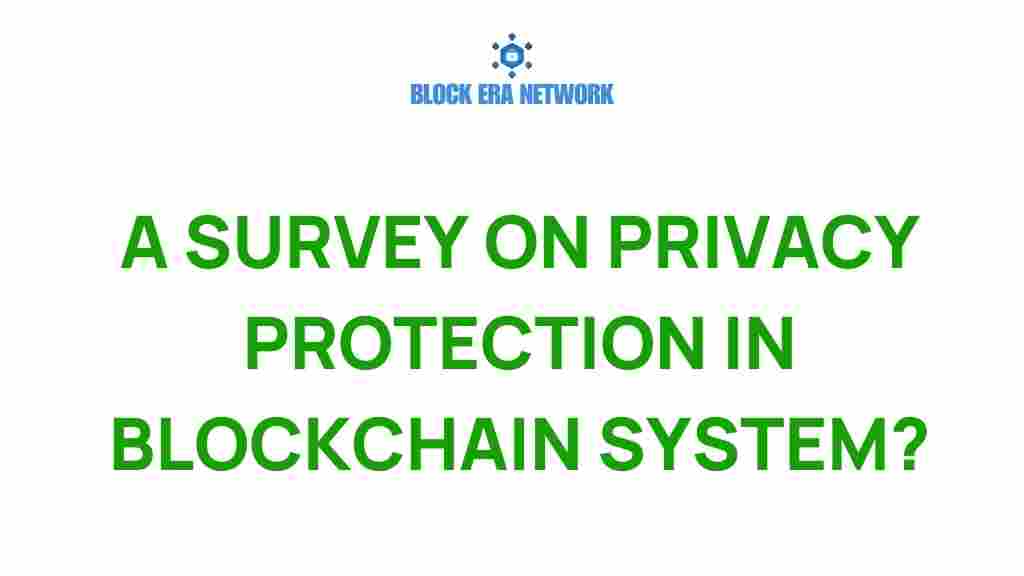Unveiling Privacy Protection in Blockchain Technology
In recent years, the rapid evolution of technology has brought forth significant concerns regarding data security and user anonymity. Among the most revolutionary advancements is blockchain technology, which promises not only to enhance transparency but also to offer robust privacy protection. This article presents a comprehensive survey of how blockchain can be utilized to protect privacy, examining various aspects such as decentralized systems, cryptography, digital trust, and the ethical considerations surrounding technology. Furthermore, we will delve into the regulatory challenges that accompany the adoption of blockchain for privacy protection.
Understanding Privacy Protection in Blockchain
Privacy protection is paramount in today’s digital landscape, where data breaches and identity theft are prevalent. Blockchain serves as a decentralized ledger that records transactions across many computers, ensuring that the data is immutable and secure. Here’s how blockchain enhances privacy protection:
- Decentralized Systems: Unlike traditional databases controlled by a single entity, blockchain operates on a network of nodes, which reduces the risk of data manipulation.
- User Anonymity: Blockchain allows users to interact without revealing their identities, as transactions can be executed using cryptographic addresses instead of personal information.
- Cryptography: Advanced cryptographic techniques ensure that data is encrypted, making it unreadable to unauthorized users.
- Digital Trust: The transparency provided by blockchain builds trust among users, as all transactions are recorded on a public ledger that can be audited.
How Blockchain Achieves Privacy Protection
Blockchain technology employs several mechanisms to ensure privacy protection:
- Public and Private Keys: Each user has a pair of cryptographic keys that facilitate secure transactions while maintaining anonymity.
- Zero-Knowledge Proofs: This innovative cryptographic method allows one party to prove to another that a statement is true without revealing any information beyond the validity of the statement.
- Mixers and Tumblers: These tools enhance user anonymity by obscuring transaction trails, making it difficult to trace the origin and destination of funds.
Step-by-Step Process of Implementing Blockchain for Privacy Protection
Implementing blockchain technology for privacy protection involves several key steps:
Step 1: Assessing Needs
Identify the specific privacy requirements of your organization or project. Consider factors such as:
- Type of data being handled
- Regulatory compliance needs
- User trust and anonymity considerations
Step 2: Choosing the Right Blockchain Platform
Select a blockchain platform that aligns with your privacy goals. Options include:
- Ethereum: Known for its smart contract capabilities.
- Hyperledger Fabric: A permissioned blockchain ideal for enterprises.
- Zcash: Focused on privacy through zero-knowledge proofs.
Step 3: Developing Privacy Protocols
Design and implement protocols that enhance privacy protection. This may include:
- Utilizing smart contracts to automate processes securely
- Implementing multi-signature wallets for added security
- Establishing privacy policies that adhere to ethical standards
Step 4: Conducting Security Audits
Regularly audit your blockchain implementation to identify vulnerabilities. Consider engaging third-party security experts for unbiased assessments.
Step 5: Educating Users
Provide training and resources to users regarding how to maintain privacy while using blockchain. This includes:
- Understanding wallet management
- Recognizing phishing attempts
- Practicing good digital hygiene
Troubleshooting Tips for Privacy Protection on Blockchain
While implementing blockchain technology for privacy protection, you may encounter challenges. Here are some troubleshooting tips:
Issue 1: Data Breaches
If you experience a data breach, assess the extent of the breach immediately:
- Review your security protocols and update them as necessary.
- Engage with cybersecurity professionals to mitigate damages.
- Notify affected users and comply with legal regulations.
Issue 2: User Confusion
If users are confused about privacy protocols:
- Enhance user education initiatives.
- Provide clear documentation and FAQs.
- Establish a support team to assist users with inquiries.
Issue 3: Regulatory Compliance Challenges
To address regulatory challenges:
- Stay updated on legislation regarding data privacy and blockchain.
- Engage legal experts to ensure compliance with regulations.
- Participate in industry groups to share insights and best practices.
Technology Ethics in Blockchain Privacy Protection
The ethical implications of blockchain technology cannot be ignored, particularly concerning privacy protection. Key considerations include:
- Data Ownership: Who owns the data on the blockchain? Users should have control over their personal information.
- Informed Consent: Users must be made aware of how their data will be used and shared.
- Transparency vs. Privacy: A balance must be struck between maintaining transparency and protecting user privacy.
Regulatory Challenges in Blockchain Privacy Protection
The landscape of blockchain technology is fraught with regulatory challenges, particularly concerning privacy protection. Some of the key challenges include:
- Compliance with GDPR: The General Data Protection Regulation imposes strict rules on data handling, which can conflict with the immutable nature of blockchain.
- Varied Regulations Across Jurisdictions: Different regions may have conflicting regulations regarding data privacy, creating challenges for global blockchain implementations.
- Reporting Requirements: Organizations may be required to report privacy breaches, which can be complicated with decentralized systems.
For further insights into regulatory challenges, visit this resource.
Conclusion
As we delve deeper into the digital age, the importance of privacy protection continues to grow. Blockchain technology presents a formidable solution for enhancing data security, user anonymity, and digital trust. However, it is crucial to navigate the ethical and regulatory landscape carefully. By understanding the mechanisms of blockchain, implementing robust privacy protocols, and addressing potential challenges, organizations can leverage this technology to safeguard user privacy effectively. Through collaboration and ongoing education, we can pave the way for a future where privacy protection and technological innovation coexist harmoniously.
For additional information on blockchain technology and its implications for privacy protection, check out our other articles here.
This article is in the category Crypto Security and created by Block Era Network Team
